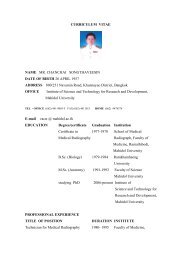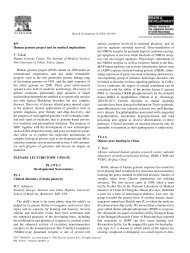The Frontal lobes - Mahidol University
The Frontal lobes - Mahidol University
The Frontal lobes - Mahidol University
Create successful ePaper yourself
Turn your PDF publications into a flip-book with our unique Google optimized e-Paper software.
19/07/54<br />
Functional areas in the frontal <strong>lobes</strong><br />
<strong>The</strong> motor system is the part of the central nervous system that is involved with<br />
movement. It consists of the pyramidal and extrapyramidal system.<br />
<strong>The</strong> motor pathway also called pyramidal tract or the corticospinal tract start in the motor<br />
center of the cerebral cortex.<br />
<strong>The</strong>re are upper and lower motor neurons in the corticospinal tract.<br />
<strong>The</strong> motor impulses originates in the Giant pyramidal cells or Betz cells of the motor area i.e.<br />
precentral gyrus of cerebral cortex. <strong>The</strong>se are the upper motor neurons (UMN) of the<br />
corticospinal tract. <strong>The</strong> axons of these cells pass in the depth of the cerebral cortex to the<br />
Corona radiata and then to the Internal Capsule passing through the posterior branch of<br />
internal capsule and continue to descend in the Midbrain and the Medulla Oblongata. In<br />
the lower part of Medulla oblongata 80 to 85% of these fibers decussate (pass to the<br />
opposite side) and descend in the White matter of the Lateral funiculus of the spinal cord<br />
on the opposite side. <strong>The</strong> remaining 15 to 20% pass to the same side. Fibers for the<br />
extremities (limbs) pass 100% to the opposite side. <strong>The</strong> fibers of the corticospinal tract<br />
terminate at different levels in the Anterior horn of the Grey matter of the spinal cord.<br />
Here the Lower Motor Neurons (LMN) of the corticospinal cord are located. Peripheral motor<br />
nerves carry the motor impulses from the anterior horn to the voluntary muscles.<br />
Pyramidal motor system:<br />
Corticospinal tracts<br />
tracts is a collection of<br />
axons that travel between the cerebral cortex<br />
of the brain and the spinal cord.<br />
<strong>The</strong> corticospinal tract mostly contains motor axons.<br />
It actually consists of two separate tracts in the<br />
spinal cord: the lateral corticospinal tract and the<br />
anterior corticospinal tract.<br />
An understanding of these tracts leads to an<br />
understanding of why for the most part, one side of<br />
the body is controlled by the opposite side of the<br />
brain.<br />
<strong>The</strong> corticobulbar tract is also considered to be a<br />
pyramidal tract, though it carries signals to motor<br />
neurons of the cranial nerve nuclei, rather than the<br />
spinal cord.<br />
<strong>The</strong> neurons of the corticospinal tracts are referred<br />
to as pyramidal neurons. <strong>The</strong> name comes from the<br />
shape of the corticospinal tracts, which somewhat<br />
resemble pyramids as they pass through the<br />
medulla.<br />
<strong>The</strong> corticospinal tract is concerned specifically with<br />
discrete voluntary skilled movements, especially of<br />
the distal parts of the limbs. (Sometimes called<br />
"fractionated" movements)<br />
<strong>The</strong> motor pathway<br />
<strong>The</strong> corticospinal tract originates from pyramidal cells in layer V of the<br />
cerebral cortex.<br />
About half of its fibres arise from the primary motor cortex. Other<br />
contributions come from the supplementary motor area, premotor<br />
cortex, somatosensory cortex, parietal lobe, and cingulate gyrus. <strong>The</strong><br />
average fiber diameter is in the region of 10μm; around 3% of fibres are<br />
extra‐large (20μm) and arise from Betz cells, mostly in the leg area of the<br />
primary motor cortex.<br />
Upper motor neurons<br />
Upper motor neurons<br />
<strong>The</strong> neuronal cell bodies in the motor cortex, together with their axons<br />
that travel down through the brain stem and spinal cord are commonly<br />
referred to as upper motor neurons. It should be noted however, that<br />
they do not project to muscles, and thus the term 'motor neuron' is<br />
somewhat misleading.<br />
2
















